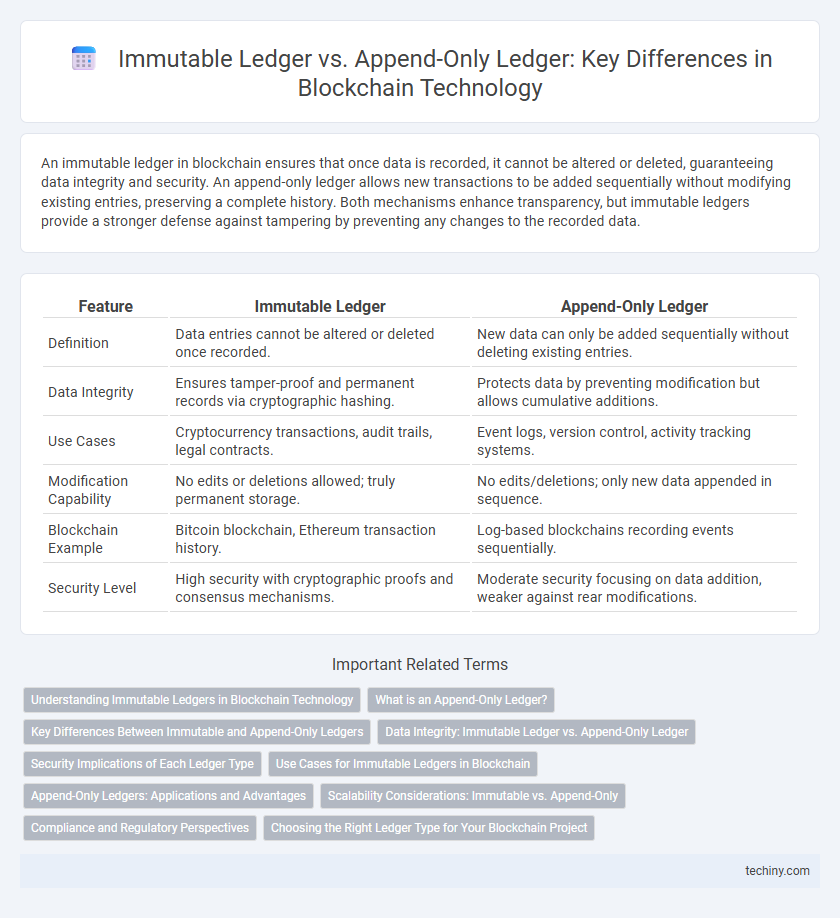An immutable ledger in blockchain ensures that once data is recorded, it cannot be altered or deleted, guaranteeing data integrity and security. An append-only ledger allows new transactions to be added sequentially without modifying existing entries, preserving a complete history. Both mechanisms enhance transparency, but immutable ledgers provide a stronger defense against tampering by preventing any changes to the recorded data.
Table of Comparison
| Feature | Immutable Ledger | Append-Only Ledger |
|---|---|---|
| Definition | Data entries cannot be altered or deleted once recorded. | New data can only be added sequentially without deleting existing entries. |
| Data Integrity | Ensures tamper-proof and permanent records via cryptographic hashing. | Protects data by preventing modification but allows cumulative additions. |
| Use Cases | Cryptocurrency transactions, audit trails, legal contracts. | Event logs, version control, activity tracking systems. |
| Modification Capability | No edits or deletions allowed; truly permanent storage. | No edits/deletions; only new data appended in sequence. |
| Blockchain Example | Bitcoin blockchain, Ethereum transaction history. | Log-based blockchains recording events sequentially. |
| Security Level | High security with cryptographic proofs and consensus mechanisms. | Moderate security focusing on data addition, weaker against rear modifications. |
Understanding Immutable Ledgers in Blockchain Technology
Immutable ledgers in blockchain technology ensure that once data is recorded, it cannot be altered or deleted, providing a tamper-proof and permanent record of transactions. Unlike append-only ledgers, which allow only new data to be added sequentially but do not guarantee unchangeability of existing entries, immutable ledgers leverage cryptographic hashing and distributed consensus mechanisms to secure every block. This cryptographic integrity and decentralized validation make immutable ledgers essential for trust, transparency, and security in blockchain ecosystems.
What is an Append-Only Ledger?
An append-only ledger is a data structure that allows new entries to be added sequentially without modifying or deleting existing records, ensuring data integrity and transparency. Unlike a fully immutable ledger, an append-only ledger permits the possibility of reverting entries under certain conditions, but all changes are chronologically documented to maintain a verifiable audit trail. This feature is critical in blockchain systems, where transaction history must be preserved for security and trust.
Key Differences Between Immutable and Append-Only Ledgers
Immutable ledgers guarantee that data, once written, cannot be altered or deleted, ensuring tamper-proof records ideal for high-trust environments like financial transactions. Append-only ledgers allow new entries to be added sequentially without modifying previous data but do not inherently prevent data deletion or reordering, often relying on external mechanisms for integrity. Key differences include immutability providing cryptographic guarantees against data alteration, whereas append-only ledgers emphasize data growth by continuous addition, impacting use cases in audit trails and compliance.
Data Integrity: Immutable Ledger vs. Append-Only Ledger
Immutable ledgers guarantee data integrity by preventing any alteration or deletion of previously recorded transactions, ensuring permanent and tamper-proof records. Append-only ledgers allow new data to be added sequentially but may permit edits or deletions under certain conditions, posing a higher risk to data integrity. The immutable nature of blockchain technology provides stronger assurance against fraud and unauthorized modifications compared to append-only systems.
Security Implications of Each Ledger Type
Immutable ledgers provide enhanced security by preventing any alteration or deletion of recorded data, ensuring data integrity through cryptographic hashing and consensus mechanisms. Append-only ledgers allow new entries to be added without modifying existing data, which supports auditability but may still permit limited data reversals or soft deletions depending on the implementation. Security implications favor immutable ledgers for high-trust environments requiring tamper-proof records, while append-only ledgers offer flexibility with moderate tamper resistance suitable for less critical applications.
Use Cases for Immutable Ledgers in Blockchain
Immutable ledgers in blockchain ensure that once data is recorded, it cannot be altered or deleted, providing unparalleled data integrity for use cases such as financial transactions, supply chain tracking, and identity verification. This immutability is critical for regulatory compliance, fraud prevention, and audit trails in industries like banking, healthcare, and government services. Append-only ledgers, while allowing data additions, do not guarantee complete data permanence, making immutable ledgers the preferred choice for secure and transparent record-keeping.
Append-Only Ledgers: Applications and Advantages
Append-only ledgers, a core component of blockchain technology, enable secure and transparent data recording by allowing new entries without modifying existing data, ensuring data integrity and auditability. Common applications include financial transactions, supply chain tracking, and digital identity management, where historical data immutability is crucial for compliance and trust. The advantages of append-only ledgers encompass resistance to tampering, enhanced transparency, and improved traceability, which collectively support decentralized and verifiable record-keeping systems.
Scalability Considerations: Immutable vs. Append-Only
Immutable ledgers store data permanently without alterations, enhancing security but potentially limiting scalability due to growing data size and resource demands. Append-only ledgers allow new entries without deleting or modifying past records, enabling more efficient data management and higher throughput under scalable architectures. Choosing between immutable and append-only models depends on balancing unchangeable auditability with performance needs in blockchain scaling.
Compliance and Regulatory Perspectives
Immutable ledgers ensure data cannot be altered or deleted, providing robust compliance with regulatory requirements for data integrity and auditability. Append-only ledgers allow new entries to be added without modifying past records, supporting transparent transaction histories while maintaining regulatory transparency. Both ledger types enhance trust and accountability in blockchain systems, but immutability offers stronger assurances against tampering in compliance environments.
Choosing the Right Ledger Type for Your Blockchain Project
Choosing between an immutable ledger and an append-only ledger depends on your blockchain project's need for data permanence versus flexibility. Immutable ledgers guarantee that recorded transactions cannot be altered or deleted, ensuring maximum data integrity and security, ideal for regulatory compliance and audit trails. Append-only ledgers allow new entries without modifying existing data, supporting use cases requiring transparent history with controlled updates, such as permissioned blockchains and enterprise applications.
Immutable ledger vs Append-only ledger Infographic

 techiny.com
techiny.com